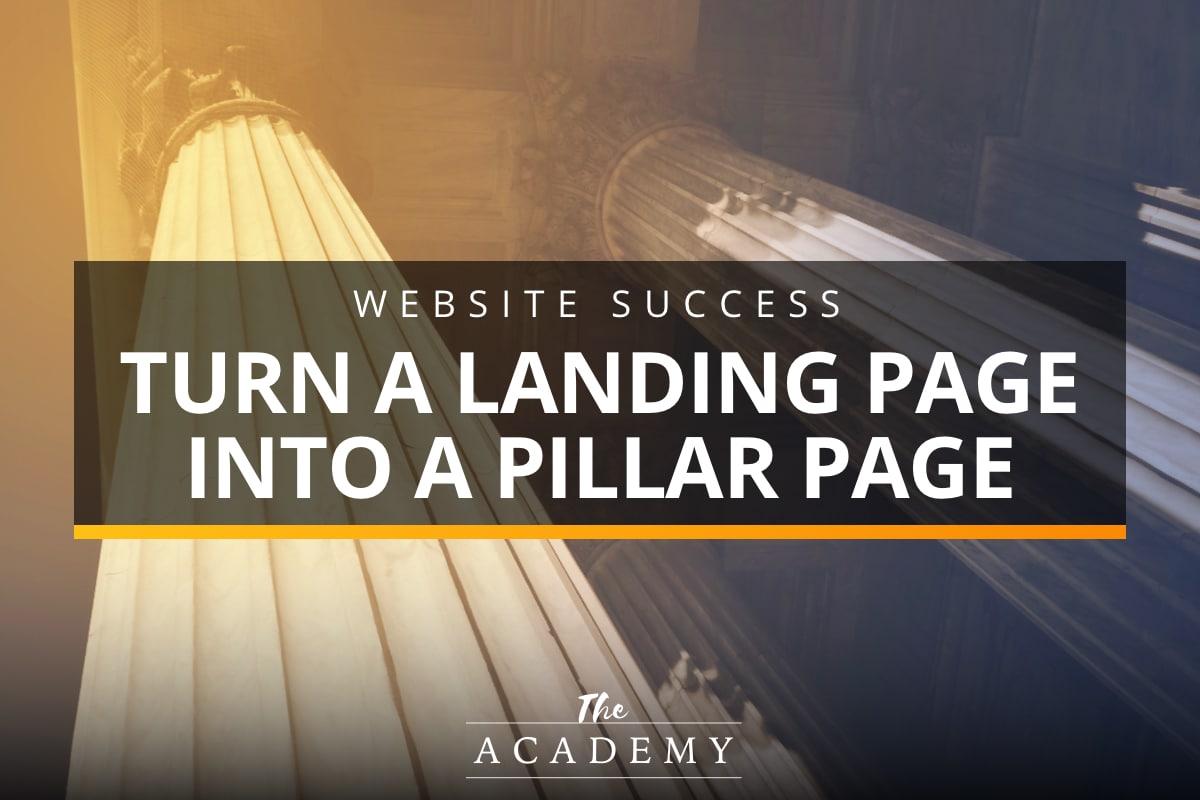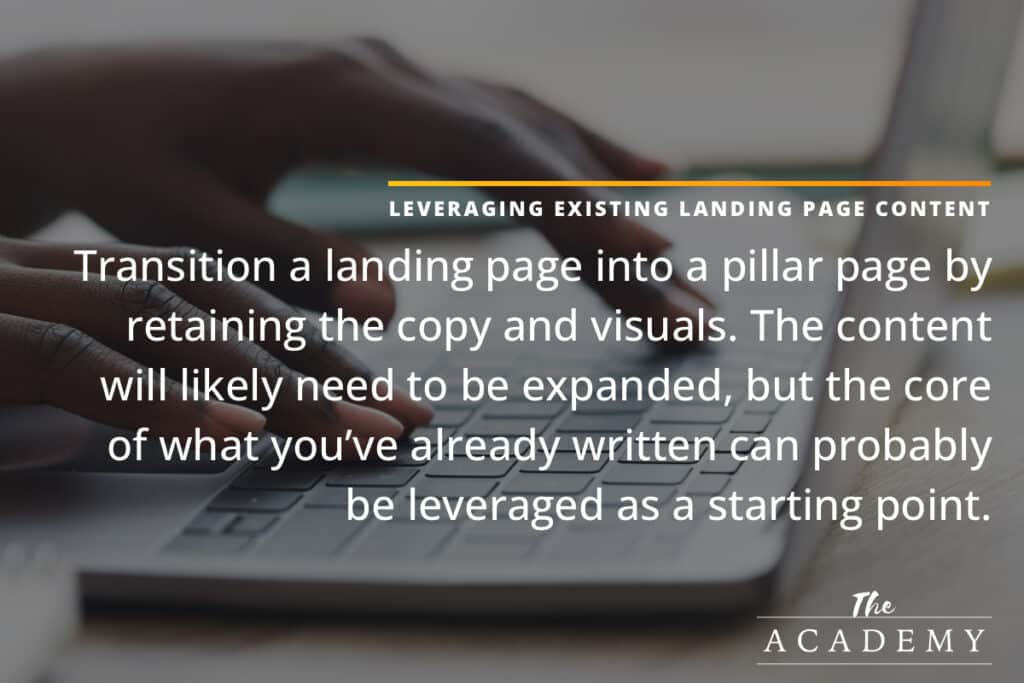
When building or managing a website, it’s important to have clear roles for each of your pages. All pages on a site are not the same; Different pages have different jobs, and they need to be designed to suit those varied roles properly. Two popular types of pages, pillar pages and landing pages, might have some things in common, but they differ in a few important ways.
With this post, we’d like to talk in more detail about these two kinds of pages and what they can do for your site. Also, we’ll discuss the idea of turning a landing page into a pillar page, and why you might want to do just that. There is a lot of ground to cover on this important topic, so let’s get started!
What is a Pillar Page?
First up, we need to create a clear definition of a pillar page. While a pillar page will likely bear some resemblance to a blog post, or even a traditional static page on your site, that doesn’t quite tell the whole story. The idea here is to create a page that contains everything your visitor needs to deeply understand a given topic. Not only does the content on the page offer an excellent education on the topic, but also the internal links featured on the page help the visitor navigate to other resources that will further their knowledge.

So, these are not short pages. There is no specific required word count for something to be classified as a pillar page, but it’s unlikely that you’ll craft a pillar page in less than 1,000 or even 2,000 words. Usually, these are huge pages, with comprehensive sections, graphics, abundant links, and more. They are so long, in fact, that they typically include a table of contents or section with “quick links” to different sections of the page. When executed correctly, good pillar pages can serve as the heart of your site, bringing in significant organic traffic and helping you to grow your audience.
For many sites, the pillar pages will serve as sort of a central hub for a cluster of other pages or posts that expand on the topic. Building these sorts of content hubs can help your site establish topical authority in a given area, which may help with search rankings over time. Between the pillar page itself and the related supporting pages, your visitors won’t need to go anywhere else to learn everything they need to know.
Let’s go through an example to help bring this concept to life. Imagine that you have a website that is all about mountain biking. Perhaps you sell bikes, or maybe smaller components that are used on those bikes. Either way, you might decide to build out a pillar page on mountain bike maintenance. This page will cover the many different types of maintenance that bike owners need to perform to keep their bikes working properly. Such a page would be interesting to your target audience and would help you build authority in the space.
So, on the mountain bike maintenance pillar page, you would have an overview of everything that goes into caring for a bike. From there, you would link out to a collection of supporting pages, each of which will tackle a smaller topic within this bigger subject. Possible supporting pages include topics such as the following:
- How to clean a mountain bike chain
- Fixing mountain bike brakes
- How to change a tire on a mountain bike
- Washing a mountain bike properly
This list could go on and on. No matter what market you happen to serve, there will be many different topics that you can write about to help educate your audience and share your knowledge in the space. When structured properly, you can center your various pieces of content around a few specific pillar pages, and it will be easy for both human visitors and search bots to understand what your site is all about.
What is the Difference Between a Pillar Page and a Landing Page?
Education is at the heart of a pillar page. When you build a pillar page, your aim is to educate the visitor on the topic at hand, and give them everything they’ll need to move forward. Of course, you can do this with the greater goal of sales in mind, but the core function of the page is to teach.
That’s not the case with a landing page. On a landing page, you are trying to get the visitor to take one specific action. They have landed (hence the name) on your site from an external source and you now want them to do something that will serve your business. The obvious example is a sales page, where you are trying to close the deal and get the visitor to make a purchase. But not all landing pages are about immediate sales. Sometimes you just want the visitor to sign up for a mailing list, or even get them to visit a second page where they will continue on in your funnel.
We can now see how landing pages and pillar pages are fundamentally different. They have different reasons for existing, and should be designed and written with the end goal in mind. Within the greater architecture of your site, you’ll have a blend of pillar and landing pages, along with other types of pages, that all work together to serve your goals.
How to Create a Great Pillar Page
Pillar pages prove to be a significant challenge for many site owners and managers because they are intimidating from the start. You are trying to tackle an entire topic on a single page, and just knowing where to begin can be a challenge. With a typical blog post, you just dive into a rather narrow subject and offer your insight or opinion. Pillar pages are like blog posts on a much larger scale, and they can be tough to do well as a result.

To help you create a useful, well-performing pillar page for your site, we’d like to offer the following pieces of advice:
- Structure is critical. You aren’t going to build a quality pillar page by just writing paragraph after paragraph with no breaks or thoughts about design. This “wall of text” approach is a mistake that is made by plenty of sites, and it will send your visitors scurrying away in no time at all. Before you start writing the content for the page, take some time to develop a thoughtful outline that will make the content more approachable and user-friendly. Then, with that outline as a guiding light, you can start writing sections until you have assembled the words you need to publish an excellent page.
- Use shortcut links. It’s possible that you will wind up with 10,000 words or more on your pillar page. Asking your visitors to scroll down through all of that content to get to the sections they are interested in is just not practical and would not make for a good user experience. So, near the top of the page, include a table of contents with shortcut links down to various headings in the content. This way, visitors will not only be able to see a list of the topics that are covered on the page, but they can also quickly jump to the section that interests them most.
- Have assets available. Even if you break up text with headers and plenty of paragraph breaks, putting nothing but text on a pillar page is not a good plan. You’ll also want to have some forms of media to add to the page, to make it more pleasing to the eye, and to augment the information you are providing in written form. This can be as simple as some stock images, or it could be custom videos that have been created just for this page—or anything in between. A great pillar page will offer up a variety of ways to consume information, from text and videos to diagrams and infographics. You might find it efficient to create most of your content first, so you have the majority of the page ready to go, and you can then decide what type of visuals would help bring it all together.
- Carefully plan the supporting pages. We’ve already talked about how supporting pages play an important role in this strategy, and you’ll want to be sure to think carefully about what supporting pages are going to be most important for your pillar to be effective. At the start, you might build between three to five supporting pages that will be linked from the pillar. Then, if the pillar starts to gain traction and is drawing traffic, you can invest time into more supporting pages to make this section of your site even more powerful.

Leveraging Existing Landing Page Content
While it’s true that landing pages and pillar pages are fundamentally different, there is likely to be some crossover that can be useful if you want to turn a landing page into the start of a pillar. Let’s loop back to our mountain bike maintenance example to demonstrate how this can work.
Imagine that you have a landing page that is aimed at getting email subscribers based on the topic of bike maintenance. You may be able to transition that page into a pillar page by retaining some of the assets like portions of the copy and some of the visuals. The content will likely need to be expanded significantly, as landing pages are usually light on content, but the core of what you’ve already written can probably be leveraged as a starting point.

Also, it’s worth considering the possibility that you could consolidate a variety of landing pages into something that comes together as a single pillar page. For instance, if you had landing pages for bike brake repair, tire installation, gear maintenance, and more, you could salvage bits and pieces until you assembled something that took the form of a pillar page. From there, you can fill in the holes, add links to supporting content, and look forward to seeing how your new pillar will perform.
If you already have a good landing page in place on a particular topic, you don’t have to throw it out completely to start over with a pillar page. Rather, you can use the ideas we’ve talked about above to transition that landing page into a pillar page that can serve your site—and your business—well for years to come. Get to work on this project today and start to reap the benefits in short order. Good luck!
Most Popular Articles

Seeing Favicons in Your Google Search Results? Here’s Why…
Have you noticed anything different in your Google Search results lately? Google added tiny favicon icons to its organic search results in January. It was…

Business Growth and Digital Marketing News & Tips 11-17-24
Are you encouraging and rewarding innovation? Lee Cockerell is the former Executive Vice President of Operations at Walt Disney World. A lover of traditional red…

Business Growth and Digital Marketing News & Tips 11-27-24
A culture of gratitude "Feeling gratitude and not expressing it is like wrapping a present and not giving it." – William Arthur Ward Beyond being…








